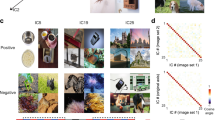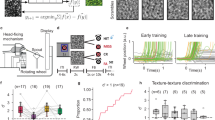Abstract
Contours and textures are important attributes of object surfaces, and are often described by combinations of local orientations in visual images. To elucidate the neural mechanisms underlying contour and texture processing, we examined receptive field (RF) structures of neurons in visual area V2 of the macaque monkey for encoding combinations of orientations. By measuring orientation tuning at several locations within the classical RF, we found that a majority (70%) of V2 neurons have similar orientation tuning throughout the RF. However, many others have RFs containing subregions tuned to different orientations, most commonly about 90° apart. By measuring interactions between two positions within the RF, we found that approximately one-third of neurons show inhibitory interactions that make them selective for combinations of orientations. These results indicate that V2 neurons could play an important role in analyzing contours and textures and could provide useful cues for surface segmentation.
This is a preview of subscription content, access via your institution
Access options
Subscribe to this journal
Receive 12 print issues and online access
$209.00 per year
only $17.42 per issue
Buy this article
- Purchase on Springer Link
- Instant access to full article PDF
Prices may be subject to local taxes which are calculated during checkout







Similar content being viewed by others
References
Hubel, D.H. & Wiesel, T.N. Receptive fields of single neurones in the cat's striate cortex. J. Physiol. (Lond.) 148, 574–591 (1959).
Hubel, D.H. & Wiesel, T.N. Receptive fields and functional architecture of monkey striate cortex. J. Physiol. (Lond.) 195, 215–243 (1968).
Kuypers, H.G., Szwarcbart, M.K., Mishkin, M. & Rosvold, H.E. Occipitotemporal corticocortical connections in the rhesus monkey. Exp. Neurol. 11, 245–262 (1965).
Van Essen, D.C., Newsome, W.T., Maunsell, J.H. & Bixby, J.L. The projections from striate cortex (V1) to areas V2 and V3 in the macaque monkey: asymmetries, areal boundaries, and patchy connections. J. Comp. Neurol. 244, 451–480 (1986).
Hubel, D.H. & Wiesel, T.N. Receptive fields and functional architecture in two nonstriate visual areas (18 and 19) of the cat. J. Neurophysiol. 28, 229–289 (1965).
Hubel, D.H. & Wiesel, T.N. Stereoscopic vision in macaque monkey. Cells sensitive to binocular depth in area 18 of the macaque monkey cortex. Nature 225, 41–42 (1970).
Smith, A.T., Singh, K.D., Williams, A.L. & Greenlee, M.W. Estimating receptive field size from fMRI data in human striate and extrastriate visual cortex. Cereb. Cortex 11, 1182–1190 (2001).
Levitt, J.B., Kiper, D.C. & Movshon, J.A. Receptive fields and functional architecture of macaque V2. J. Neurophysiol. 71, 2517–2542 (1994).
Hubel, D.H. & Livingstone, M.S. Segregation of form, color, and stereopsis in primate area 18. J. Neurosci. 7, 3378–3415 (1987).
Hegde, J. & Van Essen, D.C. Selectivity for complex shapes in primate visual area V2. J. Neurosci. 20, RC61 (2000).
Mahon, L.E. & De Valois, R.L. Cartesian and non-Cartesian responses in LGN, V1, and V2 cells. Vis. Neurosci. 18, 973–981 (2001).
Ito, M. & Komatsu, H. Representation of angles embedded within contour stimuli in area V2 of macaque monkeys. J. Neurosci. 24, 3313–3324 (2004).
Fisher, N.I. & Marron, J.S. Mode testing via the excess mass estimate. Biometrika 88, 499–517 (2001).
Fisher, N.I. Statistical Analysis of Circular Data (Cambridge Univ Press, New York, 1993).
Berry, D.A. Statistics: A Bayesian Perspective (Duxbury, Belmont, California, 1996).
Heeger, D.J. Half-squaring in responses of cat striate cells. Vis. Neurosci. 9, 427–443 (1992).
DeAngelis, G.C., Ohzawa, I. & Freeman, R.D. Neuronal mechanisms underlying stereopsis: how do simple cells in the visual cortex encode binocular disparity? Perception 24, 3–31 (1995).
Kobatake, E. & Tanaka, K. Neuronal selectivities to complex object features in the ventral visual pathway of the macaque cerebral cortex. J. Neurophysiol. 71, 856–867 (1994).
Polat, U. & Sagi, D. Lateral interactions between spatial channels: suppression and facilitation revealed by lateral masking experiments. Vision Res. 33, 993–999 (1993).
Polat, U. & Sagi, D. The architecture of perceptual spatial interactions. Vision Res. 34, 73–78 (1994).
Field, D.J., Hayes, A. & Hess, R.F. Contour integration by the human visual system: evidence for a local “association field”. Vision Res. 33, 173–193 (1993).
Rubin, N. The role of junctions in surface completion and contour matching. Perception 30, 339–366 (2001).
Nakayama, K., He, Z.J. & Shimojo, S. Visual surface representation: a critical link between lower-level and higher-level vision. in An Invitation to Cognitive Science Vol. 2 (eds. Kosslyn, S. & Osherson, D.N.) 1–70 (MIT Press, Cambridge, Massachusetts, 1995).
Riesenhuber, M. & Poggio, T. Hierarchical models of object recognition in cortex. Nat. Neurosci. 2, 1019–1025 (1999).
Carandini, M., Heeger, D.J. & Movshon, J.A. Linearity and normalization in simple cells of the macaque primary visual cortex. J. Neurosci. 17, 8621–8644 (1997).
Maffei, L. & Fiorentini, A. The unresponsive regions of visual cortical receptive fields. Vision Res. 16, 1131–1139 (1976).
De Valois, R.L., Thorell, L.G. & Albrecht, D.G. Periodicity of striate-cortex-cell receptive fields. J. Opt. Soc. Am. A 2, 1115–1123 (1985).
DeAngelis, G.C., Freeman, R.D. & Ohzawa, I. Length and width tuning of neurons in the cat's primary visual cortex. J. Neurophysiol. 71, 347–374 (1994).
Walker, G.A., Ohzawa, I. & Freeman, R.D. Disinhibition outside receptive fields in the visual cortex. J. Neurosci. 22, 5659–5668 (2002).
Dobbins, A., Zucker, S.W. & Cynader, M.S. Endstopped neurons in the visual cortex as a substrate for calculating curvature. Nature 329, 438–441 (1987).
Rust, N.C., Mante, V., Simoncelli, E.P. & Movshon, J.A. How MT cells analyze the motion of visual patterns. Nat. Neurosci. 9, 1421–1431 (2006).
Skottun, B.C. et al. Classifying simple and complex cells on the basis of response modulation. Vision Res. 31, 1079–1086 (1991).
Silverman, B.W. Using kernel density estimates to investigate multimodality. J. R. Stat. Soc. Ser B Methodol. 43, 97–99 (1981).
Watson, G.S. Goodness-of-fit tests on a circle. Biometrika 48, 109–114 (1961).
Brown, B.M. Grouping corrections for circular goodness-of-fit tests. J. R. Stat. Soc. Ser B Methodol. 56, 275–283 (1994).
Efron, B. Bootstrap methods: another look at the jackknife. Ann. Stat. 7, 1–26 (1979).
Press, W.H., Flannery, B.P., Teukolsky, S.A. & Vetterling, W.T. Modeling of data. Numerical Recipes in C: The Art of Scientific Computing 517–565 (Cambridge Univ. Press, New York, 1988).
Acknowledgements
We thank D. Marcus and J. Hegde for their participation in data collection and S. Kumar, E. Reid, M. K. Harmon, and C. Faulkner for their assistance with experiments. We are grateful to E. Kaplan for his advice on propofol, to S. Marron for information on mode testing and to G. DeAngelis for his comments and suggestions on the manuscript. This work was supported by a grant from the US National Eye Institute (EY 02091).
Author information
Authors and Affiliations
Contributions
A.A. conceived the project, designed and performed the experiments and wrote the manuscript; X.P. performed the experiments; D.C.V. supervised and contributed in all phases of the project including data collection.
Corresponding author
Rights and permissions
About this article
Cite this article
Anzai, A., Peng, X. & Van Essen, D. Neurons in monkey visual area V2 encode combinations of orientations. Nat Neurosci 10, 1313–1321 (2007). https://doi.org/10.1038/nn1975
Received:
Accepted:
Published:
Issue Date:
DOI: https://doi.org/10.1038/nn1975
This article is cited by
-
Elevated Intraocular Pressure Moderated Brain Morphometry in High-tension Glaucoma: a Structural MRI Study
Clinical Neuroradiology (2024)
-
Spatial contextual effects in primary visual cortex limit feature representation under crowding
Nature Communications (2020)
-
Intrinsic network architecture predicts the effects elicited by intracranial electrical stimulation of the human brain
Nature Human Behaviour (2020)
-
Adaptation reveals multi-stage coding of visual duration
Scientific Reports (2019)
-
Cross-orientation suppression in visual area V2
Nature Communications (2017)



